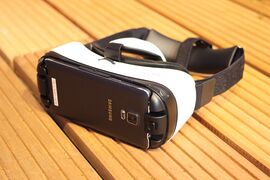Samsung Gear VR
Samsung Gear VR is a VR headset add-on developed by Samsung and Oculus VR. It is a shell that requires a smartphone.
Succeeding the Gear VR Innovator Edition, Samsung Gear VR is Oculus Rift's first consumer mobile gadget and the 2nd gadget in the Gear VR series. To use Gear VR, users need to mount a 2015 or newer Samsung Smartphone inside it. The smartphone serves as the screen and also as the computer. Gear VR has additional IMUs and Oculus' rotational tracking technology built within, so it does not solely rely on the smartphone's IMU(s) for tracking.
The Gear VR does not have positional tracking.
The Gear VR was announced during Oculus Connect 2. It was released in November 20, 2015 for $99. Users who pre-ordered Galaxy S7 and S7 edge would receive the HMD for free.
Hardware[edit]
Gear VR works with 2015 or newer Samsung smartphones such as Galaxy S7, Galaxy S7 edge, Galaxy S6, Galaxy S6 edge, Galaxy S6 edge+ and Galaxy Note 5. All phones must be running Android Lollipop 5.0.1 and newer to work with the headset.
Comparing to other mobile HMDs:
Gear VR has high quality lenses for better viewing quality and a touchpad for input. It also does not rely on the smartphone's IMUs for head tracking. Gear VR has IMUs built within, allowing for fast and accurate rotational tracking.
Comparing to Innovator Edition:
The design of Gear VR is less bulky and more streamlined than its predecessor. By replacing some plastic parts for webbing and mesh, Gear VR is 22% lighter than the Innovator Edition. A soft layer of microfleece is added where the HMD meets the user's face. The touchpad on the side the HMD now has small grooves that guide the user's fingers in the 4 directions.
Specifications[edit]
Head-Mounted Display[edit]
| Part | Spec |
|---|---|
| Field of View | 96° (nominal) |
| Dimensions | 201.9 x 116.4 x 92.6 mm |
| Weight | 318g |
| Interpupillary Distance | 55-71 mm???? |
| Sensors | Accelerator, Gyrometer, Proximity |
| Tracking | 3 degrees of freedom (rotational) |
| Update Rate | Rotational Tracking: 1000 Hz, high accuracy |
| Latency | Motion to Photon Latency: Less than 20ms |
| Focal Adjustment | Covers Nearsighted / Farsighted Eyes |
| Input | Touchpad, Back Button, Volume Key, Focus adjustment wheel |
| Connectivity | microUSB connection to the Smartphone |
Smartphones[edit]
| Spec | S6 | S6 edge | S6 edge+ | Note 5 |
|---|---|---|---|---|
| Display size | 5.1" | 5.1" | 5.7" | 5.7" |
| Resolution | 2560 x 1440 | 2560 x 1440 | 2560 x 1440 | 2560 x 1440 |
| Pixel density | 577 PPI | 577 PPI | 518 PPI | 518 PPI |
| Screen shape | Flat | Curved | Curved | Flat |
| RAM | 3 GB RAM | 3 GB RAM | 4 GB RAM | 4 GB RAM |
| Storage | 32/64/128 GB | 32/64/128 GB | 32/64 GB | 32/64 GB |
| Battery | 2550 mAh | 2600 mAh | 3000 mAh | 3000 mAh |
| Weight | 138 g | 132 g | 153 g | 171 g |
- Note that all 5 phones have identical CPU and GPU.
Accessories[edit]
Apps[edit]
VR apps from Oculus Store
To use Google Cardboard apps, users must install CB Enabler for Gear VR[1].
Oculus Cinema, Oculus 360 Photos, Oculus 360 Videos and VR Gallery.
Developer[edit]
Oculus Mobile SDK[edit]
Oculus Mobile SDK is initially developed for Gear VR.
History[edit]
September 24, 2015: Samsung Gear VR CV1 is announced during Oculus Connect 2.
November 20, 2015: Samsung Gear VR CV1 was released for $99.
January 30, 2016: Video capture function is added to Gear VR SDK.
Feburary 21, 2016: During Android World, Samsung announced that users will receive a free Samsung Gear VR for each pre-order of Galaxy S7 or Galaxy S7 Edge smartphone.
May 11, 2016: Oculus VR announced that Gear VR has reached over 1 million monthly users in April 2016 and over 250 apps in the Oculus Home for Gear VR.[2]
January 4, 2017: Samsung announced that 5 million Gear VR headsets are sold to date.
May 10, 2017: Samsung sold 782,000 units of Gear VR in Q1 2017[3].
